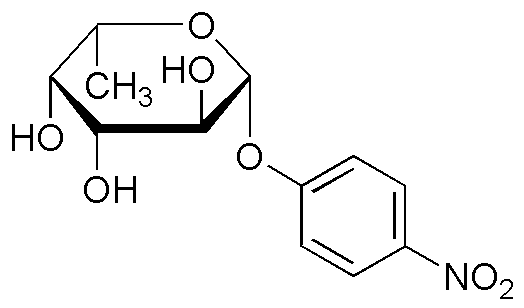4-Nitrophenyl-b-L-fucopyranoside is widely utilized in research focused on:
- Enzyme Activity Assays: This compound serves as a substrate for various glycosidases, allowing researchers to measure enzyme activity and study carbohydrate metabolism.
- Biochemical Research: It is used in studies involving carbohydrate-binding proteins, helping scientists understand interactions between sugars and proteins.
- Drug Development: The compound aids in the design of new pharmaceuticals by providing insights into glycosylation processes, which are crucial for drug efficacy.
- Food Industry: It can be applied in the analysis of sugar content and quality in food products, contributing to quality control and product development.
- Diagnostics: This chemical is utilized in diagnostic assays for detecting specific enzymes in clinical samples, enhancing the accuracy of medical tests.
General Information
Properties
Safety and Regulations
Applications
4-Nitrophenyl-b-L-fucopyranoside is widely utilized in research focused on:
- Enzyme Activity Assays: This compound serves as a substrate for various glycosidases, allowing researchers to measure enzyme activity and study carbohydrate metabolism.
- Biochemical Research: It is used in studies involving carbohydrate-binding proteins, helping scientists understand interactions between sugars and proteins.
- Drug Development: The compound aids in the design of new pharmaceuticals by providing insights into glycosylation processes, which are crucial for drug efficacy.
- Food Industry: It can be applied in the analysis of sugar content and quality in food products, contributing to quality control and product development.
- Diagnostics: This chemical is utilized in diagnostic assays for detecting specific enzymes in clinical samples, enhancing the accuracy of medical tests.
Documents
Safety Data Sheets (SDS)
The SDS provides comprehensive safety information on handling, storage, and disposal of the product.
Product Specification (PS)
The PS provides a comprehensive breakdown of the product’s properties, including chemical composition, physical state, purity, and storage requirements. It also details acceptable quality ranges and the product's intended applications.
Certificates of Analysis (COA)
Search for Certificates of Analysis (COA) by entering the products Lot Number. Lot and Batch Numbers can be found on a product’s label following the words ‘Lot’ or ‘Batch’.
*Catalog Number
*Lot Number
Certificates Of Origin (COO)
This COO confirms the country where the product was manufactured, and also details the materials and components used in it and whether it is derived from natural, synthetic, or other specific sources. This certificate may be required for customs, trade, and regulatory compliance.
*Catalog Number
*Lot Number
Safety Data Sheets (SDS)
The SDS provides comprehensive safety information on handling, storage, and disposal of the product.
DownloadProduct Specification (PS)
The PS provides a comprehensive breakdown of the product’s properties, including chemical composition, physical state, purity, and storage requirements. It also details acceptable quality ranges and the product's intended applications.
DownloadCertificates of Analysis (COA)
Search for Certificates of Analysis (COA) by entering the products Lot Number. Lot and Batch Numbers can be found on a product’s label following the words ‘Lot’ or ‘Batch’.
*Catalog Number
*Lot Number
Certificates Of Origin (COO)
This COO confirms the country where the product was manufactured, and also details the materials and components used in it and whether it is derived from natural, synthetic, or other specific sources. This certificate may be required for customs, trade, and regulatory compliance.


